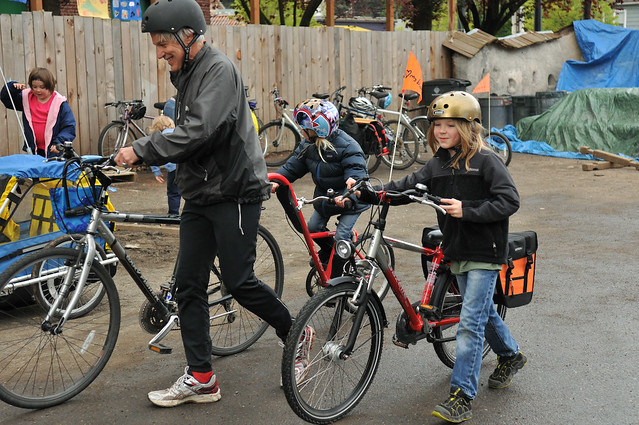
(Photo by J.Maus/BikePortland)
Slowly but surely, Portland seems to be edging toward its transportation goal for elementary schoolers: getting as many of them to walk or bike to school as the average American kid did in 1969.
For the last two years, progress has leveled off, just as the city’s goals for adult transportation have. But (much like workplaces) some local elementaries have been far more successful than others.
A pair of reports released this week from the city’s Safe Routes to School programs shows that 41 percent of Portland pupils either walked or biked to school in fall 2013, compared to about 12 percent nationally.
Much of Portland’s success, city Safe Routes manager Gabe Graff said Thursday, is due to the fact that Portland’s schools remain integrated with neighborhoods, while many faster-growing districts have built new schools on the edges of cities in an effort to save tax dollars.
Among Portland elementary schoolers who live less than a mile from their school, 56 percent bike or walk; nationally, it’s 35 percent.
In 1969, 89 percent of American elementary schoolers who lived within a mile of school walked or biked.
“Most of the elementary schools in our city were built around that time or before,” Graff said. “They weren’t built for the numbers of parents that are driving there, dropping kids off in their personal automobile that we’ve seen. … Once we get our numbers closer to the mode share we got in the 60s, then the pickup and dropoff around our schools will get more sane.”
As the map below shows, the Portland elementary school that gets closest to that target is Sabin in inner Northeast Portland, where 59 percent of K-5 pupils walk and another 15 percent bike.
In the map, schools where more than half of students walk or bike are marked in green. Those where fewer than 30 percent do so are marked in red. Click on a marker for more information: as you can see, many schools where biking and walking are less common have high bus ridership. (Though not as high as similar schools would have in 1969, when only 14 percent of students who lived more than two miles from school were dropped off in cars.)
Before we wrap up, let’s look at another map: the schools where the highest share of pupils who use active transportation to get to school do so on a bike.
The 13 elementary schools marked in purple are the ones where walking might not be so common but (because of distance, street design, parents’ schedules or something else) more than 30 percent of active commutes happen on a bike.
In the whole city, there are two traditional elementary schools where biking to class is actually more common among K-5 students than walking: Llewellyn School, in Southeast Portland’s Moreland neighborhood just off the Springwater path; and Harvey Scott School, in the Roseway neighborhood, at Northeast 68th and Prescott.
The location of those schools might be a lesson for biking in the city in general: though biking for transportation is very common for local trips in the city’s innermost neighborhoods, it’s the next ring out — the neighborhoods built not in the 1910s and 1920s but in the 40s, 50s and 60s — where getting around on a bike is often the most convenient option, and the way to really transform a life.
Correction 1:20 pm: An earlier version of this post incorrectly described the funding for the city program. Most of it comes from speeding tickets and other traffic fines.

